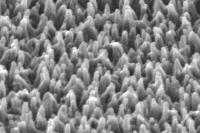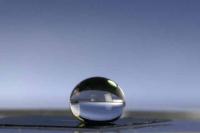|
|
||||
| Nanotechnology | ||||
Transparent nano-fibre film can be designed to conduct electricity, repel dirt, attract oil19 July 2007 A new technique for making a film of tiny plastic fibres with customisable properties could lead to new products as diverse as transparent electronic devices, self-cleaning surfaces and biomedical tools that manipulate strands of DNA.
The patent-pending technology developed by researchers at Ohio state University involves growing a bed of fibres of a specific length, and using chemical treatments to tailor the fibres' properties. When seen with the naked eye the surfaces look as flat and transparent as a sheet of glass. But seen up close, the surfaces are actually carpeted with tiny fibres. The research was published in the June issue of the journal Nature Nanotechnology. Arthur J. Epstein, Distinguished University Professor of chemistry and physics and director of the university's Institute for Magnetic and Electronic Polymers, said "One of the good things about working with these polymers is that you're able to structure them in many different ways. Plus, we found that we can coat almost any surface with these fibres." For this study, the scientists grew fibres of different heights and diameters, and were able to modify the fibres' molecular structures by exposing them to different chemicals.
Different treatments made the fibres repel or attract water or oil. Depending on the polymer used, the fibres can also be made to conduct electricity or attract strands of DNA. When the researchers put droplets of water containing DNA on the fibres, the strands uncoiled and hung suspended from the fibres like clotheslines. Epstein said scientists could use the fibres as a platform to study how DNA interacts with other molecules. They could also use the spread-out DNA to build new nanostructures. "We're very excited about where this kind of development can take us," said Epstein, whose research centres on polymers that conduct electricity, and light up or change colour. Depending on the choice of polymer, the nano-fibre surface can also conduct electricity. The researchers were able to use the surface to charge an organic light-emitting device — a find that could pave the way for transparent plastic electronics. Finally, they also showed that the fibres could be used to control the flow of water in microfluidic devices — a speciality of study co-author L. James Lee, professor of chemical and biomolecular engineering and head of Ohio State's Center for Affordable Nanoengineering of Polymeric Biomedical Devices. The technology is a merger of two different chemical processes for growing polymer molecules: one grows tiny dots of polymer 'seeds' on a flat surface, and the other grows vertical fibres out from the top of the seeds. The fibres grow until the scientists cut off the chemical reaction, forming a carpet of uniform height. The university will license the technology, and Epstein and his colleagues are looking for new applications for it. Lee and Epstein are advisors to former graduate student Nan-Rong Chiou, who developed the technology to earn his doctorate. Aside from anti-fog windows, self-cleaning windows, and organic LEDs, Chiou said that he foresees the surfaces working in glucose sensors, gene therapy devices, artificial muscles, field emission displays, and electromagnetic interference shielding.
|

